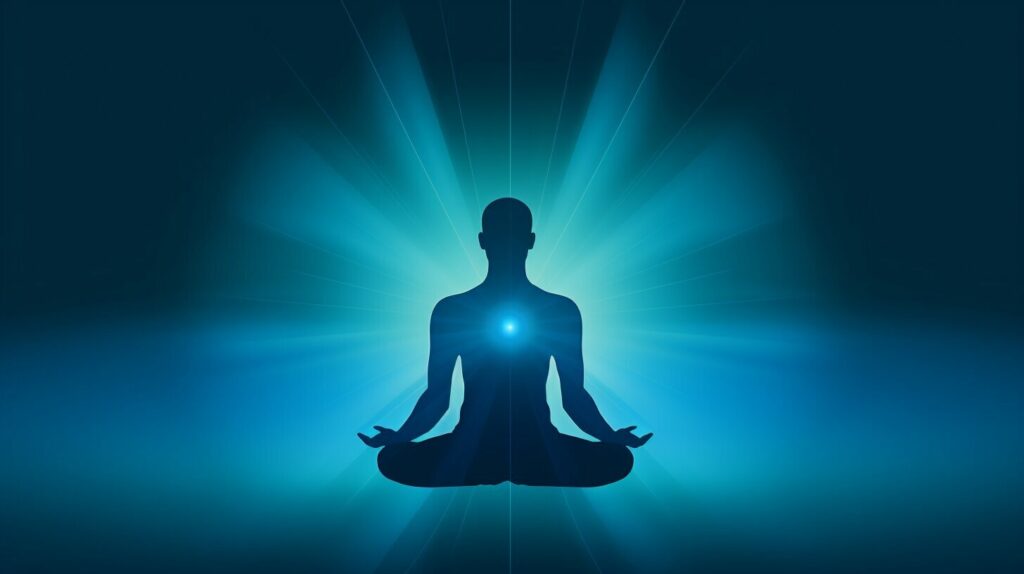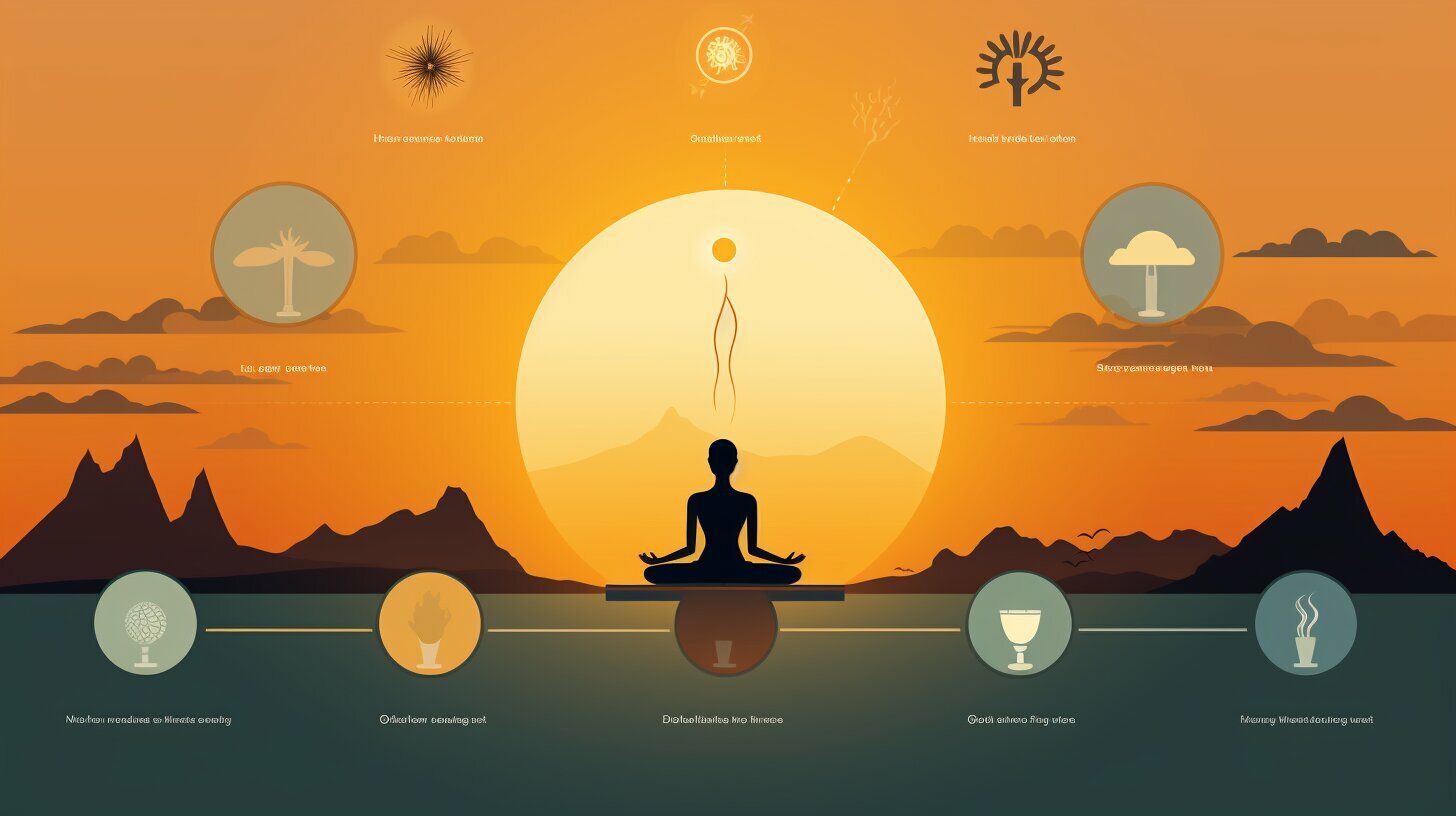Meditation is an ancient practice that holds powerful benefits for relaxation, increased awareness, and overall well-being. There exist various techniques of meditation, each with its own set of advantages and specific focuses on different aspects of the mind and body.
Whether you’re new to meditation or have been practicing for a while, trying out different techniques can be beneficial in finding the one that resonates with you and allows you to incorporate the benefits of meditation into your everyday life. There are various types of meditation techniques to choose from, ranging from traditional practices such as Zen and mantra meditation to more contemporary approaches like mindfulness and movement-based meditation. With this variety, there’s a technique suitable for everyone to explore.
Zen Meditation: Cultivating Stillness and Clarity
Zen meditation, a practice rooted in Buddhism, is a highly effective technique that focuses on developing stillness and clarity of mind. By sitting and following the breath, individuals can access their inner wisdom and attain a profound sense of calm.
Zazen is a central practice in Zen meditation. It involves sitting in a stable and comfortable position and bringing attention to the breath. This practice aids in calming the mind and increasing awareness of the present moment. Through non-judgmental observation of thoughts and sensations, practitioners gain insight into the workings of their own minds and cultivate acceptance.
The benefits of Zen meditation extend beyond the meditation cushion. Regular practice can lead to reduced stress levels, improved concentration, and enhanced emotional well-being. It can also promote self-reflection and self-discovery, allowing individuals to gain insight into their true nature and connect with their inner selves.
| Benefits of Zen meditation: | Techniques of Zen meditation: |
|---|---|
|
|
Whether you are a beginner or an experienced meditator, Zen meditation offers a path towards inner peace and self-transformation. By regularly dedicating time to sit in stillness and observe the breath, you can cultivate a deeper connection with yourself and the world around you. So take a moment to find a quiet space, sit comfortably, and embark on the journey of Zen meditation.

“Meditation is not a way of making your mind quiet. It’s a way of entering into the quiet that’s already there.” – Deepak Chopra
As Deepak Chopra beautifully expresses, meditation is a practice that enables us to connect with the inherent tranquility that exists within all of us. Zen meditation specifically, with its focus on stillness and lucidity, offers a profound tool for accessing this inner peace. By committing dedicated time to sit in mindful meditation, we can personally experience the transformative effects it has on our overall well-being.
Whether you decide to delve into Zen meditation or explore other techniques, it’s important to remember that the practice of meditation is a personal journey. Embrace the stillness, clarity, and peace that await you within.
Key Takeaways:
- There are various types of meditation techniques, each with its own unique benefits.
- Exploring different techniques can help reduce stress, improve focus, and enhance overall well-being.
- Popular meditation techniques include Zen meditation, mantra meditation, and mindfulness meditation.
- Choosing a meditation technique that resonates with you is essential for long-term practice and integration into daily life.
- Regular meditation practice can have profound effects on mental, emotional, and physical health.
Mantra Meditation: Harnessing the Power of Sound
Mantra meditation is a potent technique that utilizes the repetition of sound to calm the mind and enhance focus. By chanting or silently repeating a mantra, individuals can cultivate inner peace and stillness. This practice has been employed for centuries across different cultures and spiritual traditions.
The term “mantra” derives from the Sanskrit language and can be defined as a “mind instrument” or a “thought vehicle.” By reciting a mantra, we establish a point of focus for our attention, enabling us to release intrusive thoughts and attain a state of profound concentration. The rhythmic sounds generated by the mantra contribute to tranquilizing the mind and facilitating the onset of meditation.
A widely recognized mantra used in meditation is “om” (pronounced as “aum”). It holds a sacred significance, representing the universal vibration that connects us to a higher level of consciousness. Chanting “om” has been found to assist in grounding the mind, alleviating stress, and fostering a feeling of unity and balance.

The practice of mantra meditation provides numerous benefits for the mind and body. Scientific research has demonstrated that regular engagement in this practice can effectively reduce stress levels, enhance focus and concentration abilities, uplift mood, and foster overall well-being. The repetitive nature of mantra meditation additionally aids in quieting the incessant mental chatter, thereby resulting in a profound sense of inner tranquility and serenity.
How to Practice Mantra Meditation
The practice of mantra meditation provides numerous benefits for the mind and body. Scientific research has demonstrated that regular engagement in this practice can effectively reduce stress levels, enhance focus and concentration abilities, uplift mood, and foster overall well-being. The repetitive nature of mantra meditation additionally aids in quieting the incessant mental chatter, thereby resulting in a profound sense of inner tranquility and serenity.
| Benefits of Mantra Meditation | How to Practice Mantra Meditation |
|---|---|
| – Reduces stress | – Find a quiet and comfortable space |
| – Improves focus and concentration | – Close your eyes and take deep breaths |
| – Enhances mood | – Choose a mantra that resonates with you |
| – Promotes overall well-being | – Repeat the mantra silently or out loud |
| – Focus on the sound and rhythm of the mantra | |
| – Bring your attention back to the mantra if the mind wanders |
Mantra meditation is a flexible and powerful technique that can be tailored to fit your personal preferences and requirements. Regardless of whether you’re new to meditation or have been practicing for years, integrating mantra meditation into your routine can support you in developing inner tranquility, calmness, and a stronger bond with both yourself and the world around you.
Vipassana Meditation: Insight into the Nature of Reality
Vipassana meditation, also called insight meditation, is a technique that involves observing the sensations of the body to gain a deeper understanding of reality. It focuses on mindfulness and self-awareness. Through heightened awareness of bodily sensations, Vipassana meditation practitioners can explore the transient nature and interconnectedness of all things.
This technique, originating from ancient Buddhist traditions, centers around cultivating mindfulness and being fully present in the current moment. It emphasizes observing bodily sensations with curiosity and acceptance, enabling individuals to gain a deeper understanding of their own physical and mental experiences.
During Vipassana meditation, practitioners focus on the physical sensations that arise and fade away in order to anchor their practice. This cultivation of acceptance and surrender to the present moment allows for a deeper understanding of the impermanence and constantly shifting nature of reality.

“Observing bodily sensations with mindfulness and non-reactivity can lead to a profound understanding of the nature of reality.” – Thich Nhat Hanh
By regularly practicing Vipassana meditation, individuals may experience various benefits. These include a clearer state of mind, improved emotional well-being, and a stronger sense of connection with oneself and the world. Additionally, it can help reduce stress, anxiety, and negative thought patterns, promoting a more balanced and harmonious way of life.
| Benefits of Vipassana Meditation: |
|---|
| 1. Enhanced self-awareness and introspection |
| 2. Reduced stress and anxiety |
| 3. Improved emotional well-being |
| 4. Greater clarity of mind |
| 5. Increased resilience and adaptability |
| 6. Deepened sense of connectedness |
| 7. Heightened ability to live in the present moment |
Vipassana meditation is an impactful and transformative practice that offers individuals the opportunity to delve deep into their true selves. Through cultivating a heightened awareness of bodily sensations and acknowledging the transient nature of all aspects of life, practitioners can gain profound insights that extend far beyond the confines of their meditation sessions. These invaluable realizations enrich their daily lives with wisdom and compassion.
Chakra Meditation: Balancing Energy Centers
Chakra meditation is a technique that aims to restore balance to the body’s energy centers, known as chakras. By focusing on these energy points and directing attention towards them, individuals can promote emotional balance, vitality, and overall harmony. Each chakra represents specific qualities and is linked to various aspects of our physical, emotional, and spiritual well-being.
During chakra meditation, individuals use different methods to activate and harmonize each chakra in order to promote the free flow of energy throughout the body. These techniques can include visualization, breathwork, affirmations, or specific movements. By working with the chakras in this way, people can address any imbalances or blockages that may be causing physical ailments or emotional disturbances.
| Chakra | Color | Location | Associated Qualities |
|---|---|---|---|
| Root Chakra | Red | Base of the spine | Grounding, stability, security |
| Sacral Chakra | Orange | Lower abdomen | Creativity, pleasure, emotions |
| Solar Plexus Chakra | Yellow | Upper abdomen | Personal power, confidence, self-worth |
| Heart Chakra | Green | Chest | Love, compassion, forgiveness |
| Throat Chakra | Blue | Throat | Communication, self-expression |
| Third Eye Chakra | Indigo | Between the eyebrows | Intuition, insight, clarity |
| Crown Chakra | Purple | Top of the head | Spirituality, connection to the divine |
By integrating chakra meditation into your wellness routine, you can access the energy centers within your body and find harmonious balance for your mind, body, and spirit. It’s important to remember that consistency and patience are crucial when searching for the best meditation techniques. Take the time to discover what truly resonates with you and embrace the transformative effects that chakra meditation can offer.

Qigong meditation is a holistic practice that combines breathwork, gentle movements, and focused intention to cultivate Qi, or life force energy. It aims to harmonize the mind and body through gentle movement meditation, promoting overall physical health and emotional well-being.
Qigong, an ancient Chinese practice, has been used for centuries to promote the balance and flow of Qi in the body. By incorporating deliberate, gentle movements with deep and mindful breathing, individuals can attain a state of tranquility, heightened energy levels, and improved mental focus.
Practicing Qigong meditation regularly offers a wide range of benefits. It helps to alleviate stress, strengthen the immune system, improve flexibility and strength, enhance concentration, and promote overall well-being. By synchronizing breath and movement, Qigong meditation enables the release of stagnant energy and fosters a tranquil and centered state of mind.
| Benefits of Qigong Meditation: |
|---|
| 1. Reduces stress and anxiety |
| 2. Boosts immune system |
| 3. Improves flexibility and strength |
| 4. Enhances mental clarity and focus |
| 5. Promotes emotional well-being |
Qigong meditation allows for the release of stagnant energy and the cultivation of a peaceful, centered state of mind.
To practice Qigong meditation, choose a calm and peaceful area where you have enough space to move and breathe comfortably. Begin by standing with your feet positioned shoulder-width apart and slightly bending your knees. Relax your shoulders, allowing your arms to effortlessly hang at your sides. Gently close your eyes or soften your gaze while focusing on the rhythm of your breath.
Start by taking slow, deep breaths. Let your belly fully expand as you inhale and contract as you exhale. As you relax and become more focused, incorporate gentle, flowing movements into your practice. Visualize your movements as connected to the energy that flows throughout your body.
Tips for practicing Qigong Meditation:
- Start with a short practice and gradually increase the duration as you become more comfortable.
- Focus on the sensation of your breath and the movements of your body, allowing any thoughts or distractions to gently pass by.
- Experiment with different Qigong exercises and find a routine that resonates with you.
- Practice Qigong meditation regularly to reap the full benefits and establish a deeper connection with your mind, body, and spirit.

Adding Qigong meditation to your wellness routine can bring about a sense of balance, harmony, and inner peace. Discover the joy in the gentle movements and the profound connection with your breath. Embrace the potential of Qigong meditation to improve your overall well-being.
Sound Bath Meditation: Healing Vibrations and Deep Relaxation
Sound bath meditation is a technique that uses resonant sounds and vibrations to promote relaxation and healing. It’s a calming and immersive experience that helps quiet the mind and nurture the body. During a sound bath, you typically lie down or sit in a comfortable position while being surrounded by symphonic sounds produced by instruments like Tibetan singing bowls, crystal bowls, gongs, and chimes.
The vibrations created by these instruments have a deep impact on our overall well-being, including our physical, mental, and emotional states. When we are enveloped in the soothing sound waves, they are able to alleviate tension, decrease stress levels, and bring calmness to the mind. Moreover, the gentle vibrations also work harmoniously with our energy centers known as chakras. Through this process, they aid in rebalancing and revitalizing the flow of energy throughout our entire body.
In a sound bath meditation session, the sounds and vibrations serve as a focal point, redirecting our attention away from distracting thoughts and external stimuli. This aids in achieving a deep state of relaxation and entering into meditation more effortlessly. By fully embracing the experience, we are able to release tension and discover a sense of inner tranquility and serenity.
Sound bath meditation is often practiced in a group setting to maximize its benefits. This allows for a shared experience of healing and connection, where the collective energy enhances the effects of the vibrations, resulting in a powerful and transformative experience.
However, sound bath meditation can also be enjoyed individually, with recorded soundscapes or guided meditations that recreate the immersive experience.
| Benefits of Sound Bath Meditation |
|---|
| Promotes deep relaxation and stress reduction |
| Enhances mindfulness and the ability to enter a meditative state |
| Calms the nervous system and promotes better sleep |
| Facilitates emotional release and healing |
| Helps to balance and harmonize energy centers |
| Supports overall well-being and promotes a sense of inner peace |
Sound bath meditation offers a transformative practice for self-care and personal development. Whether practiced in a group setting or individually, this immersive experience promotes deep relaxation, alleviates stress, and cultivates inner tranquility. Delight in the healing vibrations of sound bath meditation as it soothes your mind, body, and spirit.
Explore Other Effective and Popular Meditation Techniques
- Zen Meditation: Cultivating Stillness and Clarity
- Mantra Meditation: Harnessing the Power of Sound
- Vipassana Meditation: Insight into the Nature of Reality
- Chakra Meditation: Balancing Energy Centers
- Qigong Meditation: Harmonizing Breath and Movement
- Mindfulness Meditation: Cultivating Present-Moment Awareness
- Spiritual Meditation: Connecting with the Higher Self
- Focused Meditation: Concentrating the Mind’s Attention
- Movement Meditation: Engaging the Body and Mind
Every meditation technique has its own set of advantages and can contribute to your overall well-being. It’s important to take the time to explore different practices and find the ones that resonate with you personally. Remember, there is no universal approach to meditation that works for everyone, so trust your intuition and choose the techniques that bring you inner peace and happiness.

Mindfulness meditation is a technique that’s widely practiced and involves cultivating awareness of the present moment without judgment. It’s a beginner-friendly practice that can be easily incorporated into daily life to reduce stress, improve focus, and promote overall well-being.
Mindfulness meditation is based on the fundamental principle of being completely present in the current moment, observing thoughts, emotions, and sensations without any judgment. This practice helps individuals enhance their self-awareness and cultivate a mindset that is non-reactive.
One of the key benefits of mindfulness meditation is stress reduction. Engaging in mindfulness meditation enables individuals to develop a heightened awareness of their thoughts and emotions. This heightened self-awareness provides them with the ability to respond to stressful situations in a more composed and calm manner.
Research has indicated that consistent practice of mindfulness meditation can lead to decreased levels of anxiety, depression, and overall psychological distress. Mindfulness meditation has the added benefit of improving focus and concentration.
Through training the mind to stay present, individuals can enhance cognitive abilities and increase productivity. This practice also helps foster emotional well-being by promoting self-compassion, empathy, and acceptance.

It’s worth mentioning that mindfulness meditation is a flexible practice that can be tailored to individual preferences. Some people enjoy meditating in silence, while others find guided meditations or using mindfulness apps to be beneficial. The most important thing is to find a method that connects with you and make a commitment to practicing regularly.
If you want to make mindfulness meditation a part of your daily routine, try dedicating a specific time each day for practice. You can start with just a few minutes and gradually increase the duration as you become more comfortable. Just remember, consistency is important in establishing this beneficial habit. Even a few minutes of daily mindfulness meditation can yield significant benefits over time.
In summary, mindfulness meditation is a beginner-friendly technique that cultivates present-moment awareness and non-judgmental acceptance. By integrating this practice into your daily life, you can reduce stress, enhance focus, and improve overall well-being. Find a method that works for you and commit to a regular practice. Start with just a few minutes a day and gradually increase the duration. Embrace the power of mindfulness and experience its transformative effects on your mind and body.
Spiritual Meditation: Connecting with the Higher Self
Spiritual meditation is a practice that goes beyond the realm of the mind and delves into the realm of the spirit. It involves connecting with one’s higher self, exploring inner wisdom, and deepening their spiritual connection. Through this form of meditation, individuals can tap into their innermost being and discover their true essence.
During spiritual meditation, individuals strive to quiet their mind and cultivate a sense of inner tranquility. By fostering a heightened level of presence and mindfulness, practitioners can surpass the confines of the ego and establish a connection with something beyond themselves. This practice frequently involves contemplating existential inquiries, reflecting on the nature of reality, and seeking profound spiritual revelations.
A fundamental element of spiritual meditation involves delving into one’s inner wisdom. This practice entails looking inward and connecting with intuition, inner guidance, and spiritual knowledge. By engaging in regular meditation, individuals can develop a deeper understanding of their purpose, values, and beliefs, thereby gaining profound insights into themselves and their role in the world.
Spiritual meditation is a transformative practice that can help individuals strengthen their spiritual connection. By fostering a sense of unity with the universe, higher powers, or divine presence, it enables individuals to experience profound peace, love, and purpose in life. Moreover, during difficult times, spiritual meditation offers solace and provides valuable spiritual support and guidance.

Overall, spiritual meditation is a transformative practice that offers individuals the opportunity to connect with their higher selves, explore their inner wisdom, and deepen their spiritual connection. By incorporating this practice into their lives, individuals can experience profound spiritual growth, enhanced self-awareness, and a greater sense of purpose and meaning.
Focused Meditation: Concentrating the Mind’s Attention
Focused meditation is a technique that involves directing and concentrating the mind’s attention on a specific object, concept, or sensation. It helps cultivate mental clarity and enhance concentration. By training the mind to stay focused on a single point of reference, individuals can develop greater awareness and control over their thoughts and emotions.
Using a visual object as the focal point can be an effective approach to focused meditation. This could involve focusing on a candle flame, a mandala, or any image that holds personal significance. By gently gazing at the chosen object and allowing distractions to fade away, the mind becomes fully immersed in the present moment. This technique not only enhances concentration but also induces relaxation and fosters a deep sense of inner calm.

A different method of practicing focused meditation involves using a particular concept or idea as the main point of focus. This could involve repeating a mantra or affirmation, like “I am calm and focused” or “I am fully present in this moment.”
By consistently redirecting attention back to the chosen phrase, it helps anchor the mind and reduce wandering thoughts. This technique can be especially helpful for individuals looking to enhance their concentration abilities and stay fully engaged in daily activities.
When practicing focused meditation, it’s crucial to approach it with patience and without judgment. It’s completely normal for the mind to wander and for thoughts and distractions to arise during the process.
Instead of becoming frustrated or disheartened, simply acknowledge these distractions and gently redirect your focus back to your chosen point of concentration. With consistent practice, you’ll find that your mind becomes more disciplined, leading to improved concentration and mental clarity in various areas of life.
Movement Meditation: Engaging the Body and Mind
Movement meditation is a widely practiced technique that combines physical movement with mindfulness to achieve a state of presence, release tension, and enhance the connection between mind and body. The beauty of this approach lies in its dynamic nature, as it encourages individuals to engage their bodies and minds simultaneously during the practice. Whether through gentle stretching, walking, dancing, or yoga, movement meditation invites us to fully embrace the present moment and savor the exquisite sensations our bodies provide
Movement meditation offers a valuable advantage in its capacity to alleviate tension and stress from the body. By actively moving and directing our focus to physical sensations, we develop increased awareness of areas where we hold tension. With this awareness, we can consciously release tension through intentional movement, resulting in relief from physical discomfort and an overall sense of relaxation.
In addition, practicing movement meditation can strengthen the connection between our mind and body. By synchronizing our movements with our breath and directing our attention to the physical sensations, we cultivate a heightened awareness of how our bodies move and operate. This heightened awareness enables us to better recognize and address our body’s requirements, resulting in enhanced physical well-being.
The Power of Mindful Movement
An effective approach to movement meditation is practicing mindful walking. This involves directing our complete focus to the act of walking, paying attention to the sensation of our feet making contact with the ground, the motion of our legs, and syncing our breath with each step. Mindful walking can be done either indoors or outdoors, offering a chance to establish a connection with nature and fully engage with our surroundings.
| Benefits of Movement Meditation | How to Get Started |
|---|---|
|
|
“Movement is a medicine for creating change in a person’s physical, emotional, and mental states.” – Carol Welch
Engaging in movement meditation provides a distinct and readily accessible method for integrating mindfulness into our everyday routines. It enables us to break away from the conventional notion of meditation as solely sitting still, instead allowing us to relish in the delight of movement and fully embrace the present moment within our physical beings.
Whether it’s a mindful walk in nature or a gentle yoga flow, movement meditation can help us find peace and balance while reaping the physical and mental benefits of a regular meditation practice.

Trying out different meditation techniques can greatly enhance your journey to wellness. Whether you prefer sitting in stillness, engaging in movement-based meditation, or even a combination of both, finding a technique that resonates with you can bring about profound benefits for your overall well-being.
Effective Meditation Techniques: Finding Your Perfect Practice
There are numerous meditation techniques to choose from, so finding one that aligns with your needs and preferences is likely. For those looking for tranquility and mental clarity, Zen meditation may be an ideal option. If utilizing sound as a tool appeals to you, mantra meditation can aid in achieving focus and inner peace. And if you’re interested in gaining insights into the nature of reality, Vipassana meditation offers a path through observing bodily sensations.
If you’re looking to achieve emotional and physical well-being by balancing your energy centers, chakra meditation can be a helpful practice. For those interested in combining breath and movement, qigong meditation offers gentle movements, breathwork, and intention to promote a balanced mind and body. And if you’re seeking deep relaxation and healing, sound bath meditation uses vibrations to induce a meditative state.
If you’re new to meditation, a great place to start is with mindfulness meditation. This particular practice focuses on cultivating awareness and acceptance of the present moment. For individuals seeking a deeper spiritual connection, spiritual meditation allows exploration of the higher self and inner wisdom. Advanced practitioners might find focused meditation beneficial, as it enhances concentration and mental clarity. And for those who prefer a more active approach, movement meditation engages both the body and mind by releasing tension and promoting presence.
If you incorporate any of these techniques into your daily routine, you can experience the countless benefits that meditation provides. From reduced stress and improved focus to enhanced mood and overall wellness, there are numerous positive outcomes waiting for you. So why not embark on a journey of self-discovery and well-being through the practice of meditation? Your mind, body, and spirit will undoubtedly express their gratitude.
FAQ
Q: What is meditation?
A: Meditation is a practice that has been used for thousands of years to develop awareness and promote relaxation.
Q: What are the different types of meditation techniques?
A: There are various types of meditation techniques to explore, including Zen meditation, mantra meditation, Vipassana meditation, chakra meditation, Qigong meditation, and sound bath meditation.
Q: What are the benefits of meditation?
A: Meditation can help reduce stress, improve focus, enhance mood, and promote overall wellness.
Q: How do I choose the right meditation technique?
A: It is important to choose a style that resonates with you and allows you to integrate the qualities experienced during meditation into your daily life.
Q: What is mindfulness meditation?
A: Mindfulness meditation involves cultivating present-moment awareness and non-judgmental acceptance.
Q: What is spiritual meditation?
A: Spiritual meditation focuses on connecting with the higher self, exploring inner wisdom, and deepening one’s spiritual connection.
Q: What is focused meditation?
A: Focused meditation involves concentrating the mind’s attention on a specific object or concept to cultivate mental clarity and enhance concentration.
Q: What is movement meditation?
A: Movement meditation involves engaging the body and mind through gentle or active movements to cultivate presence and release tension.
Q: How can meditation improve my overall well-being?
A: Meditation can reduce stress, improve focus, enhance mood, and promote overall wellness.
Q: Which meditation technique is best for beginners?
A: Mindfulness meditation and movement meditation are popular choices for beginners.
Q: Are there advanced meditation techniques?
A: Yes, spiritual meditation and focused meditation are considered more advanced techniques.









